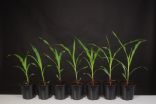Predicting tornadoes months or even seasons in advance
2015-09-11
(Press-News.org) What if tornado activity could be forecasted months, even seasons in advance? Thanks to a new model developed at the University of Toronto Scarborough, that ability could soon become a reality.
"The aim is to predict ahead to the following year or subsequent years about whether we'll get above or below average tornado activity in a given area," says Vincent Cheng, a postdoctoral fellow in UTSC's Ecological Modelling Lab.
The model, developed by Cheng, Professor George Arhonditsis and Professor Bill Gough in UTSC's Climate Lab along with colleagues at Environment Canada, uses large-scale atmospheric variables like those used by weather forecasters. But instead of looking to predict a tornado on any specific day, it looks at variations in monthly and seasonal tornado activity relative to changes in atmospheric conditions over the same period.
Cheng says the model predicts how different conditions in the atmosphere during a thunderstorm will affect the risk of there being a tornado. The key variables the model relies on includes the instability of the atmosphere and vertical windshear, which is the change in wind speed and wind direction at different heights. These variables are important since there's a much higher risk of a tornado taking place when air is able to rise quickly coupled with a big change in wind speed and direction at different heights above the ground.
Cheng's model also takes into account the lack of accurate records in tracking tornadoes. Tornado reports rely solely on eyewitness observations, which means they're better monitored in more populated areas. The model bypasses that by showing the strong relationship between atmospheric variables and actual tornado occurrences. The result sheds light on why actual tornado activity in Canada is vastly underestimated.
"From observations there are only about 60 reported tornadoes in Canada per year, but that number is more like 150," says Cheng. "When we apply the model to areas where the monitoring network is lacking we find the greatest difference is in the Northern Great Plains and the Canadian Prairies."
Cheng says there is also a significant data gap in northwestern Ontario and that more attention should be paid to that part of the province. The model is explained in a research paper that was published in the journal Nature Communications.
While much remains unknown about how tornadoes actually form, when one does it produces a narrow, violently rotating channel of air that runs from the base of a thunderstorm to the ground. They are one of nature's most hazardous weather events, capable of causing significant destruction and devastation including severe injuries or death.
Canada is second only to the United States in the number of tornadoes experienced, with more than half of them taking place in the Prairies and Northern Ontario and a third in Southern Ontario.
The goal, says Cheng, is to be able to predict whether there will be above or below average tornado activity in a given area over a given time. This information can play an important role in disaster planning or determining how tornado-resistant buildings need to be in a given area.
INFORMATION:
[Attachments] See images for this press release:

ELSE PRESS RELEASES FROM THIS DATE:
2015-09-11
Genetic mutations called "escape variants" in the deadly Ebola virus appear to block the ability of antibody-based treatments to ward off infection, according to a team of U.S. Army scientists and collaborators. Their findings, published online this week in the journal Cell Reports, have implications for the continued development of therapeutics to treat Ebola virus disease, which has claimed the lives of over 11,000 people in West Africa since last year.
Ebola virus overruns the immune system, thus overwhelming the host's ability to fight off the infection. One strategy ...
2015-09-11
PhD candidate Matt Shultz has discovered the first massive binary star, epsilon Lupi, in which both stars have magnetic fields. A binary star is a star system consisting of two or more stars, orbiting around their common centre of mass.
For the past few years, the BinaMIcS (Binarity and Magnetic Interactions in various classes of Stars) collaboration, formed to study the magnetic properties of close binaries, has been trying to find such an object. They have now discovered one using the Canada-France-Hawaii Telescope.
"The origin of magnetism amongst massive stars is ...
2015-09-11
LEXINGTON, Ky. (Sept. 8, 2015) -- A new University of Kentucky study in the journal mBio shows that tissue cysts of the parasite Toxoplasma gondii, long thought to be dormant, are quite active.
Led by Anthony Sinai, professor at the UK College of Medicine, the study has significant implications on the understanding of chronic toxoplasmosis in the brain, a condition suggested to contribute to a range of neurological diseases including schizophrenia in humans, and the modulation of behavior in rodents.
Toxoplasmosis can be acquired from the droppings of infected cats ...
2015-09-11
Using metallic osmium (Os) in experimentation, an international group of researchers have demonstrated that ultra-high pressures cause core electrons to interplay, which results in experimentally observed anomalies in the compression behavior of the material.
Os is one of Earth's most exceptional elemental materials, possessing the highest known density at ambient pressure, one of the highest cohesive energies and melting temperatures, and an incompressibility that is almost comparable to that of diamond.
Researchers believe that the ability to affect core electrons ...
2015-09-11
Open source lab equipment is the focus of a new study, published in Science and Public Policy. Joshua Pearce, an associate professor of materials science and engineering as well as electrical and computer engineering at Michigan Tech, led the research. Pearce proposes that instead of spending millions of dollars every year replacing quickly obsolescent equipment, that money could be redirected to developing open source tools that are "upgradeable and transformable--they will be continuously updated" using digital manufacturing techniques such as 3-D printing.
The benefits ...
2015-09-11
The politics of climate change are often depicted as a simple battle, between environmentalists and particular industries, over government policy. That's not wrong, but it's only a rough sketch of the matter. Now a paper co-authored by MIT economist Christopher Knittel fills in some important details of the picture, revealing an essential mechanism that underlies the politics of the climate battle.
Specifically, as Knittel and his colleagues demonstrate, at least one climate policy enacted by Congress -- on transportation fuels -- contains a crucial asymmetry: It imposes ...
2015-09-11
The aging process is associated with declines in brain function, including memory and how fast our brain processes information, yet previous research has found that higher levels of cardiorespiratory fitness in older adults leads to better executive function in the brain, which helps with reasoning and problem solving. Higher cardiorespiratory fitness levels have also been found to increase brain volume in key brain regions.
A new study from a team at the Beckman Institute for Advanced Science and Technology at the University of Illinois reveals the connection between ...
2015-09-11
UPTON, NY--In the Daya Bay region of China, about 55 kilometers northeast of Hong Kong, a research project is underway to study ghostlike, elusive particles called neutrinos. Today, the international Daya Bay Collaboration announces new findings on the measurements of neutrinos, paving the way forward for further neutrino research, and confirming that the Daya Bay neutrino experiment continues to be one to watch.
The latest findings involve measurements that track the way neutrinos change types or flavors as they move, a characteristic called neutrino oscillation. By ...
2015-09-11
VIB and UGent scientists have developed a new method which allows them to predict the final size of a plant while it is still a seedling. Thanks to this method, which is based on the knowledge that a set of genes is associated with the final size of a leaf, scientists will be able to significantly accelerate plant breeding programs. The VIB/UGent scientists were able to identify this set of genes through advanced and highly detailed analyses. Expression analysis of specific genes will help breeders select the most useful crossing products at a very early stage.
Smart ...
2015-09-11
Tyrosine kinase 2 (Tyk2) is an enzyme involved in intracellular signalling and has an important role in activating the immune system. But enzymatically active Tyk2 can also promote excessive immune reactions and growth of certain cancer types.
Since several years, scientists are developing substances to specifically inhibit the kinase activity of Tyk2 for the treatment of inflammatory diseases and for potential use in cancer therapy. However, complications may occur: Tyk2 crucially contributes to the maturation and activation of natural killer (NK) cells. NK cells form ...
LAST 30 PRESS RELEASES:
[Press-News.org] Predicting tornadoes months or even seasons in advance


